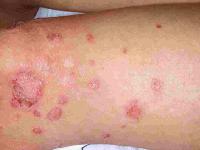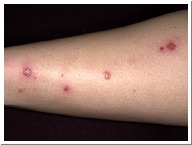


IMPETIGO
 |
 |
 |
Introduction
Paul wasn't too surprised when he got a case of poison ivy after a weekend camping trip - he'd had that problem before. But this time it was different. On parts of his arms where the rash had first appeared, he soon developed new kinds of blisters that oozed and then crusted over. After a visit to the doctor, Paul learned that he had more than poison ivy. He also had a skin infection called impetigo.
What Is Impetigo?
Impetigo is a skin infection typically caused by one of two bacteria: group A streptococcus (the same bacteria that cause strep throat) or staphylococcus aureus. These fairly common bacteria are found on the skin of healthy people. When the skin is broken - like with a cut or a scratch - they can enter the open wound and cause impetigo. Someone who becomes infected develops blisters that usually burst, ooze fluid, and then harden into a honey-colored crust.
Impetigo can affect skin anywhere on the body but often attacks the area around the nose and mouth. It is more likely to show up on skin that is already irritated or raw from eczema, poison ivy, or a skin allergy to soap or makeup. Infected bug bites are also a common cause of impetigo, especially during the summertime.
Touching the infected skin and then touching another part of the body can spread the infection to that spot. It also can be spread to someone else if another person touches the infected area. Because kids in preschool and elementary school have lots of close contact with other kids, impetigo occurs most commonly in them, but anyone can get it.
What Are Its Signs and Symptoms?
Tiny blisters are the first symptom of impetigo caused by group A streptococcus. When the blisters burst, the skin underneath them is moist, red, and may ooze fluid. Next, a tan or yellow-brown crust covers the wet areas, making it look like they've been coated with honey or brown sugar.
A staphylococcus infection may cause larger blisters filled with fluid that starts out clear but then becomes cloudy. These blisters usually remain whole without bursting longer than the blisters from streptococcus impetigo do. It can be difficult to tell if a case of impetigo is caused by strep or staph bacteria. But the treatment is similar, no matter which type of bacteria caused the infection.
How Is Impetigo Diagnosed and Treated?
Doctors usually diagnose impetigo based on how it looks and treat the infection with antibiotics. Your doctor probably will prescribe an antibiotic ointment. If the impetigo has spread to a lot of places, or if the ointment isn't working, you may need to take an antibiotic pill. It's important to finish all of the medicine prescribed even if the spots clear up quickly.
Because impetigo can spread from person to person through contact with the infected area, someone who has it should stay home from school while the infection is still contagious. Impetigo usually is no longer contagious after about 24 to 48 hours of treatment. After 3 days of treatment it should start to heal and scab over.
If your skin doesn't begin to heal after this time, or if you develop a fever, call your doctor again. You should also let your doctor know right away if skin around the impetigo becomes red, warm, swollen, or tender.
What Can I Do to Help Myself Feel Better?
In addition to taking or applying your medicine exactly as your doctor directed, you can gently wash the infected areas twice a day with an unscented soap and water, using a piece of clean gauze. If a spot is crusted, soak it in warm, soapy water for a while to remove built-up layers of the crust. You do not need to get rid of all of the crust, but it is important to keep the area clean.
To avoid spreading impetigo to other parts of the body, cover the infected areas with gauze and tape or a loose plastic bandage. It's also a good idea to keep your fingernails short until the infection clears up. Even though impetigo may itch, try not to scratch because scratching can spread the infection or tear the skin and make it worse. Scratching repeatedly can lead to scarring of the skin. If the itching continues, ask your mom or dad about taking an anti-itching medication like diphenhydramine. This could get you over the hump and prevent further scratching.
Can I Prevent Impetigo?
The best way to prevent impetigo is to follow good hygiene practices. Take a bath or shower regularly and use soap to keep your skin clean. Watch for skin that is injured, irritated, or raw - including cuts, scrapes, bug bites, areas of eczema, and rashes - and keep these areas clean and covered.
If someone in a family has impetigo, that person should cover the sores to prevent the infection from spreading to others in the house. The person with the infection should not share clothing, towels, or bed linens with anyone else. When they get dirty, wash these items separately in very hot water. Using paper towels instead of cloth towels can also help keep the infection from spreading to other people in the house. Sharing makeup is not a good idea at any time but more risky if you or your friend have impetigo.
Disclaimer: This information is not intended be a substitute for professional medical advice. It is provided for educational purposes only. You assume full responsibility for how you choose to use this information.
Reviewed by: Kate Cronan, MD
Date reviewed: January 2006
Originally reviewed by: Stephen C. Eppes, MD